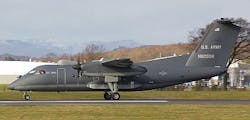Army asks industry to fill urgent need for COMINT aboard Bombardier Dash-8 aircraft
Officials of the Army Communications, Electronics, Research, Development and Engineering Command (CERDEC) Intelligence and Information Warfare Directorate (I2WD) at Aberdeen Proving Ground, Md., this week issued a request for information (W15P7T14RA152) for the Airborne Communications Intelligence Subsystem program.
Army experts want a COMINT-collection system that fits on a Bombardier De Havilland DHC-8-300 series aircraft. The RFI is not a formal solicitation, Army officials caution, and no contract is guaranteed to result from the announcement.
Candidate COMINT systems must be mature enough to have prototypes ready, per the U.S. Department of Defense (DOD) Technology Readiness Level (TRL) 7, for installation and testing aboard a Dash-8 aircraft.
This RFI is the result of a critical army requirement for a worldwide, self-deployable intelligence, surveillance, and reconnaissance (ISR) capability that can begin operations immediately when arriving in theater and sustain long-term operations, Army officials say.
The system should be able to provide not only COMINT, but also radar and imagery intelligence to provide warfighters with real-time targeting, suppression of enemy air defenses, signal mapping, and small scale contingency (SSC) operations by detecting enemy movers, sitters, and emitters.
The COMINT collection system must be able to provide direction finding (DF), recognition, copy, and exploitation against conventional and modern signals. It also must provide signal identification and target location, and be controllable by four on-board operators using DCGS-A workstations and via remotely located workstations.
The system must provide a seamless interface to operational ground station (OGS), current reporting networks, and to national data bases. Army researchers especially are interested in reliability and low sustainment costs.
Companies interested should email responses no later than 18 Nov. 2013 to [email protected]. For questions or concerns phone the Army's Kellie Lamar-Reevey at 443-861-4640.
More information is online at https://www.fbo.gov/notices/a4f4dc2b2c98fa8403d2740fcf34106a.
